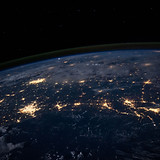What does climate change mean for Internet users?
The link between air travel and climate change is not one-way. Air travel contributes to climate change by producing greenhouse gases. But climate change will also affect air travel itself.
The Internet runs on a global network of cables and connection points, under sea and over land. Within the next 15 years, important parts of this infrastructure will likely be damaged by rising sea waters.
-
A 2018 study, focused on the US, mapped projected sea level rises that are 'locked in' to occur due to climate change to Internet infrastructure in coastal areas in the US.
-
The study found that, by 2033, 4,067 miles of fiber conduit will be under water and 1,101 nodes will be surrounded by water. Most of this infrastructure was built in the 1990s and 2000s, and designed to be water and weather resistant but not to be under water permanently.
-
The areas in the US that will be most affected are New York, Miami and Seattle, where significant amount of at-risk Internet infrastructure is located.
-
This study provides a conservative analysis, and did not consider i) infrastructure damage due to other types of climate-related threats (e.g. storms), ii) how coastal infrastructure damage can lead to cascading failures on inland assets, iii) the degree of risk to users and businesses due to the infrastructure failure, and iv) risk internationally (outside the US).
Where's the evidence?
-
Durairajan, R., Barford, C., and Barford, P. (2018) "Lights Out: Climate Change Risk to Internet Infrastructure", ANRW '18: Proceedings of the Applied Networking Research Workshop, Association for Computing Machinery. Available at http://pages.cs.wisc.edu/~pb/anrw18_final.pdf.
-
rising sea water levels will affect Internet connections
What are Internet service providers doing about it?
[Placeholder]

